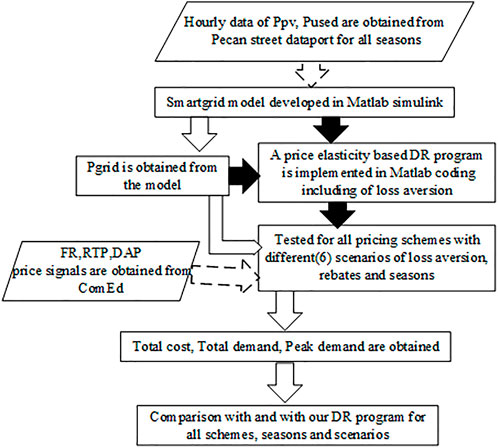Report on an Innovative Algorithm for Sustainable Energy Management in Residential Water Heaters
Introduction
A patent-pending algorithm developed at Purdue University’s College of Engineering presents a significant advancement in demand-response technology for electric water heaters. This innovation is poised to deliver substantial benefits to utility providers, manufacturers, and consumers by optimizing energy consumption. The technology directly supports several United Nations Sustainable Development Goals (SDGs), particularly those focused on energy, infrastructure, and sustainable communities.
Technological Innovation and Functionality
Developed by Levi Reyes Premer, a graduate research assistant in the School of Mechanical Engineering, the algorithm enables remote management of water heaters to mitigate peak electricity demand. By estimating household water usage with a novel, cost-effective method, the system facilitates intelligent load shifting without compromising user comfort.
Methodology
The core of the innovation is its ability to derive water usage data without expensive hardware. The system operates as follows:
- It utilizes a single additional temperature sensor on the water inlet line.
- Combined with existing temperature readings within the water heater, the algorithm estimates hot water consumption patterns for a household.
- Based on these patterns, it develops a usage forecast.
- This forecast allows the water heater to be intelligently controlled, preheating water before anticipated demand-response events.
This approach eliminates the need for individual flow meters, which can add $30 to $100 per unit, making intelligent demand-response capabilities economically viable for widespread adoption.
Contribution to Sustainable Development Goals (SDGs)
The Purdue algorithm provides a tangible solution for advancing global sustainability targets. Its implementation has direct and positive impacts on several key SDGs.
SDG 7: Affordable and Clean Energy
- Energy Efficiency: The system significantly reduces energy consumption during peak hours, a primary target of SDG 7.
- Affordability: By optimizing energy use, the technology can save residents hundreds of dollars over the lifespan of a water heater, making energy more affordable.
- Grid Stability: Enhanced demand-response capabilities help stabilize the electrical grid, which is crucial for integrating intermittent renewable energy sources and ensuring a reliable supply of clean energy.
SDG 9: Industry, Innovation, and Infrastructure
- Innovation: This algorithm represents a significant technological innovation in the field of energy management.
- Resilient Infrastructure: By reducing stress on local power transmission equipment, the technology helps build more resilient energy infrastructure. This can defer or eliminate the need for costly infrastructure upgrades, saving utilities hundreds of thousands of dollars and contributing to sustainable industrialization.
SDG 11: Sustainable Cities and Communities
- Resource Management: The technology promotes the efficient use of electricity, a critical resource for sustainable urban living.
- Sustainable Systems: Widespread adoption contributes to more stable and sustainable energy systems within cities and communities, reducing the environmental footprint of residential areas.
SDG 12: Responsible Consumption and Production
- Sustainable Consumption: The algorithm encourages a shift in electricity consumption patterns, moving demand away from peak times and promoting more responsible energy use among consumers.
Validation and Performance
Field Testing
The algorithm was rigorously validated under real-world conditions at Purdue’s DC Nanogrid House. The tests, conducted in a cold-climate residential setting, demonstrated the system’s high degree of accuracy and reliability.
Results
- The hot water usage estimation algorithm achieved 95%-98% accuracy over a month-long test period.
- The system successfully enabled preheating strategies that maintained user comfort during simulated demand-response events, even during periods of high hot water usage.
This research, supported by the Center for High Performance Buildings and the National Science Foundation, has been peer-reviewed and was presented at the 2025 American Society of Heating, Refrigerating and Air-Conditioning Engineers (ASHRAE) Annual Conference.
Commercialization and Future Development
The intellectual property for the algorithm is protected by a patent application filed by the Purdue Innovates Office of Technology Commercialization. Ongoing research is focused on refining the control algorithms and enhancing the water draw estimation techniques. Industry partners interested in commercializing this technology are invited to engage with Purdue’s development and licensing managers to help scale this solution for broader impact on sustainable energy infrastructure.
SDGs Addressed in the Article
SDG 7: Affordable and Clean Energy
The article focuses on a technology designed to manage electricity consumption, which is central to SDG 7. The algorithm helps stabilize the electrical grid by reducing power usage during peak hours, making energy distribution more efficient and reliable. It also aims to lower energy costs for consumers, directly supporting the goal of affordable energy.
- The text states the technology’s purpose is to “reduce peak electricity usage” and “stabilize the electrical grid.”
- It also highlights that the innovation “reduces homeowner energy costs” and can “save residents hundreds of dollars on their energy bills.”
SDG 9: Industry, Innovation, and Infrastructure
This goal is addressed through the development and application of a new, innovative technology (the algorithm) to upgrade existing infrastructure (electric water heaters and the power grid). The article details a patent-pending innovation from a university research center, aimed at creating more resilient and efficient infrastructure while being cost-effective.
- The article describes a “patent-pending innovation” developed at Purdue University’s College of Engineering.
- It aims to improve infrastructure by “reducing stress on local power infrastructure” and lowering “the need for costly infrastructure upgrades.”
SDG 11: Sustainable Cities and Communities
The technology contributes to making cities more sustainable by improving the efficiency of essential services like electricity. By enabling effective demand-response programs, the algorithm helps manage urban energy consumption, reduces costs for residents, and makes the community’s power infrastructure more resilient.
- The article explains that demand-response programs “help protect power grid infrastructure” in residential areas.
- The technology’s widespread adoption could lead to “significant cost savings by reducing stress on local power infrastructure,” which is a key component of sustainable city management.
SDG 13: Climate Action
While not the primary focus, the article’s subject matter is relevant to climate action. Improving energy efficiency and reducing peak electricity demand are crucial strategies for mitigating climate change. By optimizing energy use, the technology reduces the overall strain on power generation, which can decrease reliance on less efficient, carbon-intensive power plants that are often used to meet peak demand.
- The core function is to “minimize power consumption during peak hours,” a key measure in reducing the carbon footprint of the energy sector.
Specific Targets Identified
SDG 7: Affordable and Clean Energy
- Target 7.3: By 2030, double the global rate of improvement in energy efficiency.
- The article’s entire premise is based on an innovation that improves energy efficiency by intelligently managing the power consumption of electric water heaters to avoid peak usage times. It is a direct contribution to more efficient energy use in households.
- Target 7.a: By 2030, enhance international cooperation to facilitate access to clean energy research and technology… and promote investment in energy infrastructure and clean energy technology.
- The article highlights research from Purdue University, supported by the National Science Foundation, and actively seeks “industry partners interested in developing or commercializing the work,” which promotes investment in and access to new energy-saving technology.
SDG 9: Industry, Innovation, and Infrastructure
- Target 9.4: By 2030, upgrade infrastructure and retrofit industries to make them sustainable, with increased resource-use efficiency and greater adoption of clean and environmentally sound technologies.
- The algorithm is a technology designed to be integrated with existing water heaters, retrofitting them to be more energy-efficient. The article states this reduces “stress on local power infrastructure” and lowers “the need for costly infrastructure upgrades.”
- Target 9.5: Enhance scientific research, upgrade the technological capabilities of industrial sectors… encouraging innovation.
- The article is a showcase of this target, detailing a “patent-pending innovation” from a university, supported by research grants, and published in a peer-reviewed conference. The effort to commercialize it through the “Purdue Innovates Office of Technology Commercialization” is a direct example of upgrading technological capabilities.
SDG 11: Sustainable Cities and Communities
- Target 11.b: By 2030, substantially increase the number of cities and human settlements adopting and implementing integrated policies and plans towards… resource efficiency, mitigation and adaptation to climate change, resilience to disasters.
- The technology enables the implementation of demand-response programs, which are integrated plans for resource (energy) efficiency and building resilience in the electrical grid. The article notes that states like California, Oregon, and Washington already have policies requiring such capabilities.
Implied Indicators for Measuring Progress
For SDG 7 Targets
- Reduction in homeowner energy costs: The article explicitly states the technology can “save residents hundreds of dollars on their energy bills.” This is a measurable indicator of progress towards affordable energy.
- Reduction in peak electricity demand: The primary goal is to “reduce peak electricity usage.” This can be measured by utilities to quantify the technology’s impact on energy efficiency.
- Cost of technology implementation: The article implies that the low cost of this technology (“approximately $10 plus small labor and networking expenses” per city sensor) compared to alternatives (“$30 to $100” per unit for a flow meter) is an indicator of its accessibility for promoting clean energy technology (Target 7.a).
For SDG 9 Targets
- Number of patents and commercialization deals: The article mentions that a patent has been applied for (track code 71062) and that the university is seeking industry partners. The number of patents granted and licenses sold would be a direct indicator of innovation and technology transfer.
- Accuracy of the technology: The article provides a specific metric: “The estimation was within 95%-98% accuracy for a total month of hot water usage.” This is a performance indicator for the new technology.
- Reduction in infrastructure spending: The claim that the technology could be “potentially saving utilities hundreds of thousands of dollars” by reducing stress on infrastructure is a key indicator of its contribution to sustainability.
For SDG 11 Targets
- Adoption rate by utilities and households: The potential for “widespread adoption by utilities” is mentioned. The number of cities or utility districts implementing this technology would be an indicator of progress towards sustainable community management.
SDGs, Targets, and Indicators Analysis
| SDGs | Targets | Indicators Identified in the Article |
|---|---|---|
| SDG 7: Affordable and Clean Energy | 7.3: Improve energy efficiency.
7.a: Promote access to clean energy research and technology. |
|
| SDG 9: Industry, Innovation, and Infrastructure | 9.4: Upgrade infrastructure for sustainability and resource-use efficiency.
9.5: Enhance scientific research and encourage innovation. |
|
| SDG 11: Sustainable Cities and Communities | 11.b: Increase cities implementing integrated policies for resource efficiency and resilience. |
|
| SDG 13: Climate Action | 13.2: Integrate climate change measures into policies and planning. |
|
Source: purdue.edu







